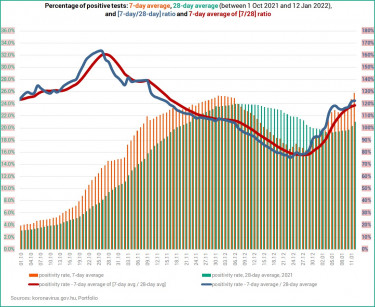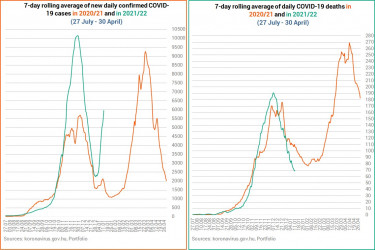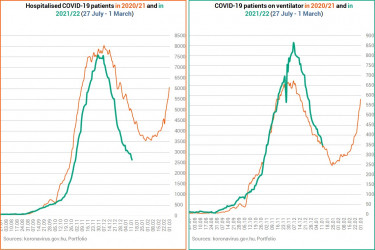COVID-19: New cases up 15% d/d, hospitalisations yet to track worsening stats


A year ago, the longer-term percent positive averages were all subsiding, while this year... well, see for yourself.

As the erratic testing practices have rendered the daily and even the short-term average positivity rates practically useless, we need to use longer-term averages to see where the pandemic is headed. Here's our 'new' indicator, the 7-d / 28-day average and its 7-day average, for two periods: starting from 1 October 2021 and starting from 1 September 2020.


The 7-day rolling average of new COVID-19 keeps on rising, and the number of Covid deaths is likely to follow suit, unless the Omicron variant causes less severe disease than Delta. While this may be true on average, experts of the World Health Organisation (WHO) warned against taking Omicron lightly.

Dr. Mike Ryan, director of the WHO’s health emergencies program, said on Wednesday that Omicron represents a “massive threat” to the lives of the unvaccinated.
Maria Van Kerkhove, the WHO’s Covid-19 technical lead, said the elderly and people with underlying conditions face an elevated risk of death compared with other groups. She added that Omicron has been detected in every country where there’s good genetic sequencing and is likely present in every nation.
It is not just a mild disease. This is really important because people are still being hospitalized for omicron,
said Kerkhove.
Van Kerkhove warned
people should not become fatalistic and resign themselves to infection,
cautioning that the long-term health implications of catching omicron remain unknown. She said people should get vaccinated, wear a well-fitting mask, avoid crowds and work from home if possible.
“It is not just a mild disease,” Van Kerkhove said. “This is really important because people are still being hospitalized for omicron.”
She was echoed by Ryan, who stressed that “there are hundreds of thousands of people around the world in hospital as we speak with the omicron variant, and for them that’s a very severe disease.”
“We can definitely say that an Omicron variant causes, on average, a less severe disease in any human being — but that’s on average,” he added.
First, here's a graph placing the green curves from the twin chart above beside each other. The observation we can make by examining the chart above is this: cases go up, deaths go up. It's that simple.

However, at this point we might have reason for cautious optimism if we take a look at the following two charts. The reason is that the number of Covid deaths per one million population appears to be dropping despite rising case numbers.
If we examine countries where the Omicron variant has been the dominant strain since the end of December, and where vaccination rates are higher than in Hungary, particulary in terms of third (booster) doses - with the exception of the US where 3rd dose coverage is 23% vs. Hungary's 34% -, we find that case numbers rose sharply, while deaths not so much.
Of course, there are various other factors that need to be taken into consideration when comparing so vastly different countries such as Hungary and Israel, Denmark or the UK. One of these is the stringency of measures put in place to stem the spread of the virus. Hungary is among the most relaxed countries in the world in this respect, and given that Prime Minister Viktor Orbán is facing a tough election challenge on 3 April, we should not expect lockdown measures to be implemented any time soon.
How's the situation in hospitals?


On the charts below the 0% line is important. When the curves are under 0% there’s a decline, when they go over 0% it’s an increase. The changes show that the situation in terms of hospitalisations started to worsen after 20 August.
More importantly, when a value is north of 0% but the curve descends, it means an increase at a slowing rate, rather than a decrease. If the curve is above 0% and ascending, it is an increase at an accelerating rate. When we are under 0% and the curve goes lower, it translates into an accelerating decrease, and when it goes up it marks a decelerating decrease. As you can see, we are witnessing the latter here, and there was a turnaround in the improvement around 27-29 December.

What do the changes mean?
The chart below shows the number of hospitalised Covid patients as a percentage of active cases and the On ventilator / In hospital ratio.
When a pandemic 'wave' starts, the percentage of hospitalised patients relative to active cases always soars, because there is still a relatively low number of official cases due to inferior testing practices, and because early on most people with positive tests are likely in hospital.
The green curve peaks around 7% in every 'wave' and then the ratio starts to drop as authorities 'find' more and more infections. The reason why this curve starts to descend even though the number of hospitalisations goes up drastically is because the increase in new confirmed COVID-19 cases is even more staggering.
When there's a relative calm, the red curve picks up sharply, because only those Covid patients are left in hospital that are in severe condition. The others either recovered and were discharged or died.
Early in these waves this ratio always rises rapidly (low number of tests, many in severe condition in hospital, a lot of them in ICUs), but then the ratio starts to improve.
There was an anomaly here, namely that this trend was broken in late November 2021. The proportion of those in hospital to active cases starts to drop, but the proportion of Covid patients in intensive care (relative to those in hospital) goes up. This indicates that there are too few people in hospital compared to before, i.e. there are more serious cases. As it is not the course of the disease that has become more severe, this indicates insufficient hospitalisation. As the number of active cases is on the rise, while the number of Covid patients in hospital is still dropping, the In hospital / Active cases ratio keeps on falling, while the other ratio (On ventilator / In hospital) remains largely unchanged; it has been hovering around 13.3-13.4% for more than two weeks now. (The ratio is currently down at 13.1%.)

Vaccination stats
While about one third of the population (3.3 mn people) are inoculated with three doses of COVID-19 vaccines, about 3.5 million people have not received a single shot yet. Also, as the effectiveness of vaccines wanes over time, about three million Hungarians have diminished or no protection against coronavirus infection, even after two jabs.
The cabinet has announced a new vaccination campaign for January where Hungarians may, after on-site registration, ask for their first, second or third dose of a COVID-19 vaccine. The shots will be administered at vaccination locations between 2 and 6 p.m. on Thursdays and Fridays and between 10 a.m. and 6 p.m. on Saturdays.
We have written about the importance of jabs, particularly third doses, at the link below.











